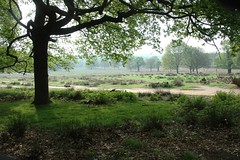| Richmond Park (Photo credit: henry…) |
Whilst there are many green squares and council parks in the center of London, not to mention expanses of protected common land slightly further out, a significant proportion of this green space is locked up in what are known as the Royal Parks; parks owned by the Crown as royal hunting parks or simply as gardens for their royal palaces. These days they are protected spaces open to the public by Crown decree and managed by the Royal Parks Agency.
There are eight Royal Parks in total within London and the following trio of articles provide an introduction to them all. Starting in the West and heading East
Bushy Park
- Location: In the borough of Richmond in the south west of London. The park sits behind the former royal residence of Hampton Court in a bend of the River Thames, bordered to the north by Teddington
- Character: The second largest of the Royal Parks at 1,100 acres, it consists of a mix of formal landscaping, woodland, grassland, streams and ponds, with the Water Gardens and grand Chestnut Avenue forming significant features. It is also dotted with sports pitches providing the homes of four local cricket clubs, a hockey club and a rugby club, as well as allotments and playgrounds.
- Attractions: Perhaps the most famous feature in Bushy Park is the Diana Fountain at the southern end of Chestnut Avenue named with an imposing golden statue of a figure thought actually to represent Arethusa, a Greek nymph. The park is still home to plenty of wildlife including herds of red and fallow deer.
- History: Originally created as a deer park by Henry VIII when he took control of Hampton Court as his royal residence, the park has subsequently evolved under successive monarchs. For example, Charles I added the Longford River Canal, whilst Chestnut Avenue and the Diana Fountain were later added, from designs by Sir Christopher Wren, to form a grand entrance to Hampton Court. The history of the park also saw it play host to the pre-World War II folk tradition of Chestnut Sunday which was resurrected in 1993, a World War I Canadian military hospital and Eisenhower’s military camp from which he planned D-Day.
- Location: Also to be found within the borough of Richmond in the south west of London. The park occupies an expanse of land just south of the River Thames in between the town of Richmond itself, neighbouring Kingston Upon Thames to the South and Wimbledon and Wimbledon Common to the West.
- Character: The largest of Royal Parks at 2,500 acres, it is the largest park in London, the second largest walled park in the UK and is over twice the size of its nearest neighbour at Bushy. The park is heavily protected as a designated National Nature Reserve and a Site of Special Scientific Interest with an informal landscape of grassland and woodland covering gentle hills and surrounding ponds at its centre. It has the sense of a country park but within the boundaries of London. More formal woodland can be found in the Isabella Plantation
- Attractions: Richmond Park is particularly noted for its wildlife including the famous Fallow and Red deer and even the more recent colonising Parakeets. It is criss-crossed with bridleways and cycle paths for those looking to explore the area on horse back or by pedal power. The park also contains a number of structures including the historic childhood home of Bertrand Russell, Pembroke Lodge, now a restaurant but complete with its own public gardens. Many will visit the park however for its opens spaces and it views of central London, the best of which perhaps can be glimpsed from King Henry’s Mound within the gardens of Pembroke Lodge
- History: The enclosed park was created initially by Charles I as a refuge from the threat of the plague. With walls that remain to this day he enclosed the extensive area of land in spite of opposition from locals, although by allowing them right of way he ensured public access down the centuries despite attempts to keep them out. Dating from the 1750s, perhaps the most notable building in the park, Pembroke Lodge has a colourful history as the home of the once Prime Minister Lord Russell, his grandson Bertrand and a military HQ during World War II
If you are looking to move to the South West of London or are already based in the area and are looking for digital marketing services then visit Wimbledon Flats or Wed Design Agency London respectively.


No comments:
Post a Comment